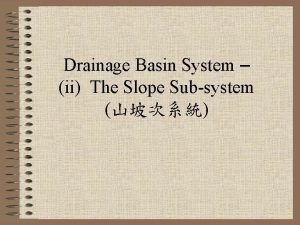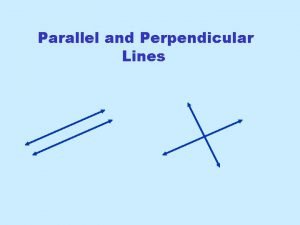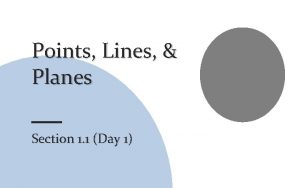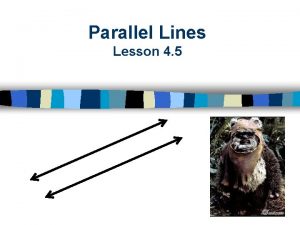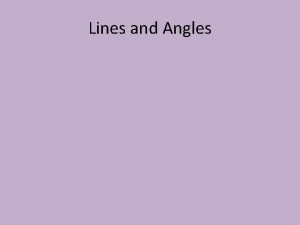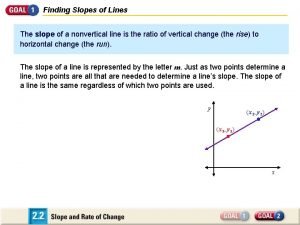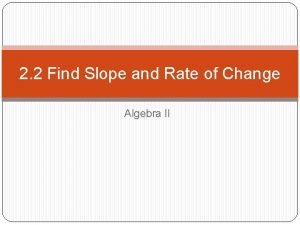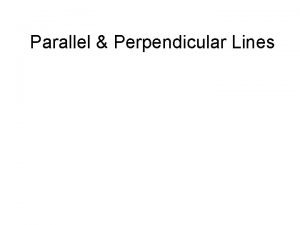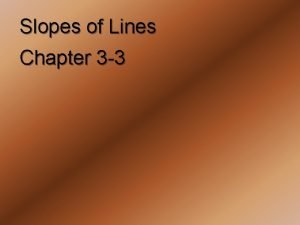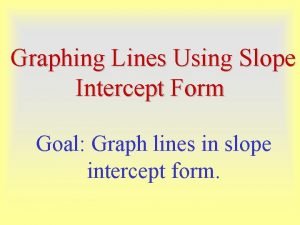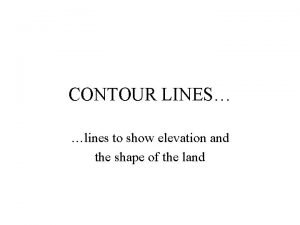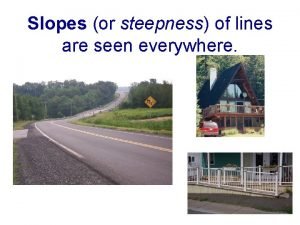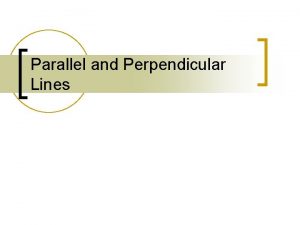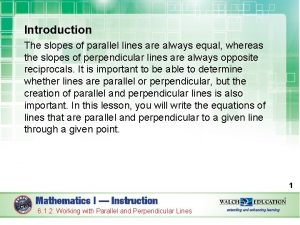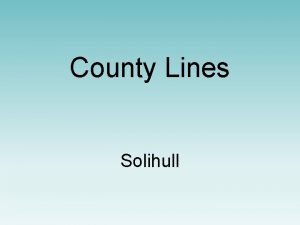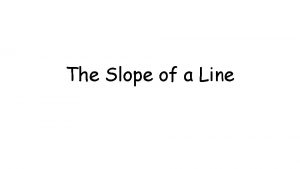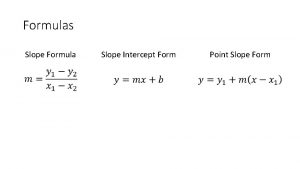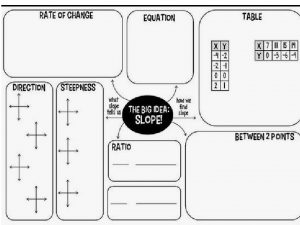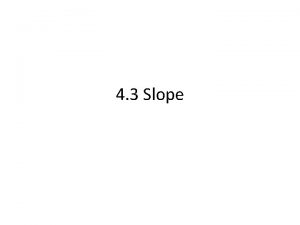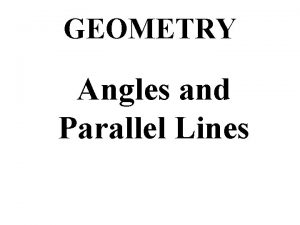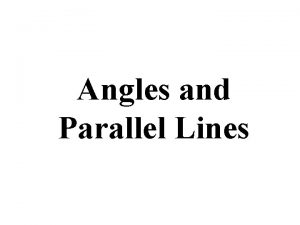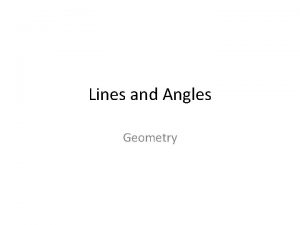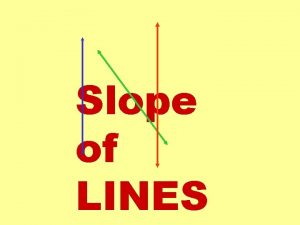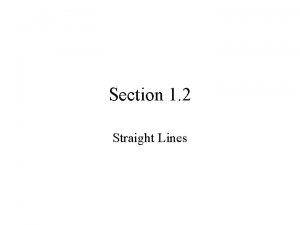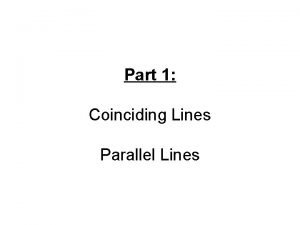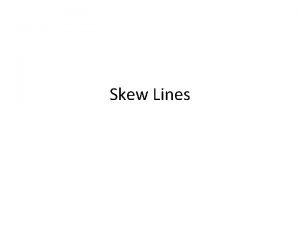Lines and Slope Definition of Slope The slope





















- Slides: 21

Lines and Slope

Definition of Slope The slope of the line through the distinct points (x 1, y 1) and (x 2, y 2) is Change in y Rise y 2 – y 1 = = Change in x Run x 2 – x 1 where x 2 – x 1 = 0. y Run x 2 – x 1 y 2 Rise y 2 – y 1 (x 2, y 2) (x 1, y 1) x 1 x 2 x

The Possibilities for a Line’s Slope Zero Slope Positive Slope y y m>0 m=0 x x Negative Slope y Undefined Slope y Line rises from left to right. Line is horizontal. m<0 m is undefined x Line falls from left to right. x Line is vertical.

Point-Slope Form of the Equation of a Line The point-slope equation of a nonvertical line of slope m that passes through the point (x 1, y 1) is y – y 1 = m(x – x 1).

Text Example Write the point-slope form of the equation of the line passing through (-1, 3) with a slope of 4. Then solve the equation for y. Solution We use the point-slope equation of a line with m = 4, x 1= -1, and y 1 = 3. y – y 1 = m(x – x 1) This is the point-slope form of the equation. y – 3 = 4[x – (-1)] Substitute the given values. y – 3 = 4(x + 1) We now have the point-slope form of the equation for the given line. We can solve the equation for y by applying the distributive property. y – 3 = 4 x + 4 Add 3 to both sides. y = 4 x + 7

Slope-Intercept Form of the Equation of a Line The slope-intercept equation of a nonvertical line with slope m and y-intercept b is y = mx + b.

Graphing y=mx+b Using the Slope and y-Intercept • Graphing y = mx + b by Using the Slope and y. Intercept • Plot the y-intercept on the y-axis. This is the point (0, b). • Obtain a second point using the slope, m. Write m as a fraction, and use rise over run starting at the yintercept to plot this point. • Use a straightedge to draw a line through the two points. Draw arrowheads at the ends of the line to show that the line continues indefinitely in both directions.

Text Example Graph the line whose equation is y = 2/3 x + 2. Solution The equation of the line is in the form y = mx + b. We can find the slope, m, by identifying the coefficient of x. We can find the y-intercept, b, by identifying the constant term. y = 2/3 x + 2 The slope is 2/3. The y-intercept is 2.

Text Example cont. Graph the line whose equation is y = 2/3 x + 2. Solution: We need two points in order to graph the line. We can use the yintercept, 2, to obtain the first point (0, 2). Plot this point on the y-axis. We plot the second point on the line by starting at (0, 2), the first point. Then move 2 units up (the rise) and 3 units to the right (the run). This gives us a second point at (3, 4). 5 4 3 2 1 -5 -4 -3 -2 -1 -1 -2 -3 -4 -5 1 2 3 4 5

Equation of a Horizontal Line • A horizontal line is given by an equation of the form • y = b • where b is the y-intercept.

Equation of a Vertical Line • A vertical line is given by an equation of the form • x = a • where a is the x-intercept.

General Form of the Equation of a Line Every line has an equation that can be written in the general form Ax + By + C = 0 Where A, B, and C are three real numbers, and A and B are not both zero.

Text Example Find the slope and the y-intercept of the line whose equation is 2 x – 3 y + 6 = 0. Solution The equation is given in general form. We begin by rewriting it in the form y = mx + b. We need to solve for y. 2 x – 3 y + 6 = 0 This is the given equation. 2 x + 6 = 3 y To isolate the y-term, add 3 y on both sides. 3 y = 2 x + 6 Reverse the two sides. (This step is optional. ) y = 2/3 x + 2 Divide both sides by 3. The coefficient of x, 2/3, is the slope and the constant term, 2, is the y-intercept.

Equations of Lines Point-slope form: y – y 1 = m(x – x 1) Slope-intercept form: y = m x + b Horizontal line: y = b Vertical line: x=a General form: Ax + By + C = 0

Slope and Parallel Lines • If two nonvertical lines are parallel, then they have the same slope. • If two distinct nonvertical lines have the same slope, then they are parallel. • Two distinct vertical lines, both with undefined slopes, are parallel.

Text Example Write an equation of the line passing through (-3, 2) and parallel to the line whose equation is y = 2 x + 1. Express the equation in point-slope form and yintercept form. Solution We are looking for the equation of the line shown on the left. Notice that the line passes through the point (-3, 2). Using the point-slope form of the line’s equation, we have x 1 = -3 and y 1 = 2. y – y 1 = m(x – x 1) 5 (-3, 2) y = 2 x + 1 4 3 Run = 1 2 y 1 = 2 x 1 = -3 1 -5 -4 -3 -2 -1 -1 -2 -3 -4 -5 Rise = 2 1 2 3 4 5

Text Example cont. Write an equation of the line passing through (-3, 2) and parallel to the line whose equation is y = 2 x + 1. Express the equation in point-slope form and yintercept form. Solution Parallel lines have the same slope. Because the slope of the given line is 2, m = 2 for the new equation. y – y 1 = m(x – x 1) 5 (-3, 2) y = 2 x + 1 4 3 Run = 1 2 y 1 = 2 m=2 x 1 = -3 1 -5 -4 -3 -2 -1 -1 -2 -3 -4 -5 Rise = 2 1 2 3 4 5

Text Example cont. Write an equation of the line passing through (-3, 2) and parallel to the line whose equation is y = 2 x + 1. Express the equation in point-slope form and yintercept form. Solution The point-slope form of the line’s equation is y – 2 = 2[x – (-3)] y – 2 = 2(x + 3) Solving for y, we obtain the slope-intercept form of the equation. y – 2 = 2 x + 6 y = 2 x + 8 Apply the distributive property. Add 2 to both sides. This is the slope-intercept form of the equation.

Slope and Perpendicular Lines Two lines that intersect at a right angle (90°) are said to be perpendicular. There is a relationship between the slopes of perpendicular lines. 90° Slope and Perpendicular Lines • If two nonvertical lines are perpendicular, then the product of their slopes is – 1. • If the product of the slopes of two lines is – 1, then the lines are perpendicular. • A horizontal line having zero slope is perpendicular to a vertical line having undefined slope.

Example Find the slope of any line that is perpendicular to the line whose equation is 2 x + 4 y – 4 = 0. Solution We begin by writing the equation of the given line in slopeintercept form. Solve for y. 2 x + 4 y – 4 = 0 4 y = -2 x + 4 y = -2/4 x + 1 This is the given equation. To isolate the y-term, subtract x and add 4 on both sides. Divide both sides by 4. Slope is – 1/2. The given line has slope – 1/2. Any line perpendicular to this line has a slope that is the negative reciprocal, 2.

Lines and Slope
 The difference between slope decline and slope retreat
The difference between slope decline and slope retreat Parallel and perpendicular lines slope intercept form
Parallel and perpendicular lines slope intercept form Points lines planes worksheet
Points lines planes worksheet Parallel lines lesson
Parallel lines lesson Short break line drawing
Short break line drawing Define parallel lines and intersecting lines
Define parallel lines and intersecting lines Point-slope form definition geometry
Point-slope form definition geometry Slope review classifying slope
Slope review classifying slope Slope review classifying slope
Slope review classifying slope Slopes of parallel and perpendicular lines
Slopes of parallel and perpendicular lines Geometry 3-3 slopes of lines answers
Geometry 3-3 slopes of lines answers Graphing lines in slope intercept form
Graphing lines in slope intercept form Concave contour lines
Concave contour lines What do perpendicular lines have in common
What do perpendicular lines have in common Parallel lines slope
Parallel lines slope Slopes of parallel lines are always
Slopes of parallel lines are always Parallel lines have the ______ slope.
Parallel lines have the ______ slope. Hát kết hợp bộ gõ cơ thể
Hát kết hợp bộ gõ cơ thể Frameset trong html5
Frameset trong html5 Bổ thể
Bổ thể Tỉ lệ cơ thể trẻ em
Tỉ lệ cơ thể trẻ em Gấu đi như thế nào
Gấu đi như thế nào
